|
|
| |
ITALY
PISA
HISTORY, LANDMARKS, MUSEUMS AND GALLERIES
Few towns in the world can boast of a past as splendid as the one of Pisa. In the course of more than ten centuries, its citizens have left a permanent mark on the history and the history and the art of western civilization. The history of Pisa is marked by an impressive series of successes: the early fights against the Saracens established Pisa's dominant position in the Mediterranean; the active participation in the Crusades led to a great expansion of its maritime trade and opened Pisa to the culture of the Moslem world; the foundation of a powerful Republic and of one of the oldest European Universities where the famous scientist Galileo Galilei was a student and later a professor.  Photo PKGAll these important events have had a great influence on Italian and European history and give Pisa, a town that is still "a mesure d'homme", the right to be considered one of the capitals of the western world.
The Leaning Tower
The Leaning Tower is the most remarkable bell tower in Europe and represents Pisa�s main attraction. The construction began in 1173 and continued after two long interruptions for about two hundred years. Originally the tower was designed to be vertical but it tilted because of the softness of the soil.  Photo PKG
The tower consists of six beautiful levels of airy and elaborately adorned colonnades, and is 52 meters tall on the north side, 54 on the south side, with almost 300 steps leading all the way to the top.
In 1990, the tower was closed to the public for safety reasons and restorations took place for over a decade. Since, December 2001 it has been reopened but the number of visitors is strictly controlled, so you must book in advance.
Baptistery  Photo PKG Located in Campo dei Miracoli, this Baptistery is the largest of its kind in all Italy. It was constructed in 1152 by Diotisalvi and different architectural styles where added during the next two centuries. Concluded with a Romanesque style and Gothic elements it contains a beautiful baptismal font and pulpit by Nicola Pisano. The other main attraction of the baptistery is its renowned acoustics, where you can enjoy singing a few notes and listening to the echoes it produces.
Cathedral di San Zeno  Photo PKGThis cathedral is one of the finest of the Romanesque period and has a strongly marked individuality. Conceived to replace the previous cathedral, the constructions began during the 12th century in two different phases but still in the 21st century its fa�ade has suffer restorations. Buscheto was the architect of this beautiful white marble building, followed by Rainaldo. Inside you can admire the monolithic columns made of granite, as well as, its silver altar and figures by Brunelleschi. Definitely a monument you don�t want to miss while visiting Pisa.  Photo PKGCamposanto
Next to the Cathedral and Baptistery you can find this beautiful graveyard built in 1278 by Giovanni di Simone. Legend says, the soil came from Holy Land and it was believed to be miraculous. Only the most illustrious teachers and member of the Medicean family had their graves here. The graveyard was decorated with frescoes made by the most famous painters of the 14th century, and also with Roman sculptures, ancient sarcophagi and statues. Although, during the war, in 1944 the cemetery was bombed and suffered a significant degradation. The restorations began in 1990 and still today they are in progress, however, it remains an artistic high point and you must include this monument in your itinerary.
Teatro Verdi
One of the main centers of cultural life in the city, offers a busy schedule along the year. Ballet and theater performances, pop and jazz concerts, opera and even seminars, lectures and workshops are held in this beautiful historical theaters of central Italy. The theater was founded in 1854 by Girolamo Pagliano and was designed by the architect Telemaco Bonaiuti. During the years, it has undergone three different renovations and nowadays it can comfortably seat over more than 1500 spectator�s.
Borgo Stretto
Nearby the Piazza del Duomo is Borgo Street, one of the most charming places in the city thanks to its typical porticoes. Know as the main shopping street in Pisa, rich in all sorts of merchandise, from clothes to books, this area also offers many pubs and bars. During the evenings its packed with an impressive number of young people that gather here to enjoy its atmosphere. If you�re in the mood for aperitifs or a cocktail, stop by �Lo Sfizio�, known as one of the best meeting points in Borgo Street.
Piazza Vettovaglie
Craft shops are very uncommon in this part of the country, but you can still enjoy the Chicco delle Vettovaglie, a fair trade shop held in the lovely Piazza Vettovaglie. This square has also hosted a colorful market for over 500 years, where you can buy all kind of fruits, vegetables and typical food. Surrounded by a nice and elegant arcade of the sixteenth century, narrow and crowded streets, you definitely should stop by and enjoy this little piece of beauty.
Festa di San Ranieri
Every June, Pisa pays tribute to its patron saint, San Ranieri. The event begins with the Illuminaria at Ponte di Mezzo. More than seventy thousand wax candles are carefully set into glasses, fixed then onto wooden frames and placed in different areas of the city. The lights of the candles reflex on the river and creates a stunning view. This tradition was interrupted during the years but has been revived since 1969 and is followed the next day by a boat race. Four boats representing the most ancient districts of the city compete in a Regatta along the Arno river. The distance covered is 1500 meters and the winner is not the first to arrive but the first to climb up the top of the boat and reach for the banner which is the symbol of the victory. The event is free of charge and is very entertaining.
Parco Naturale di Migliarino, San Rossore, Mass
This national park was established in 1979 and offers over 24,000 hectares of nature. Away from the busy urbanized area of Pisa, here you can enjoy an endless number of fauna and flora and beautiful landscapes. The park offers different admittance and visit possibilities but the best way to discover the area is by requesting the services of guided tours. Also, if you have an interest for conservation or research, different activities dedicated to environmental education are held here by experts.
Il Museo della Navigazione
After visiting towers, churches, squares and even a cemetery, you might still have time to stop by at the new museum of navigation. This forgotten port came back to life when in 1998 workers from the train station found 10 ancient roman wooden ships. Most of the content in the ships survived and are on display at this museum, including a sailors skeleton.
Still today, excavations and restorations are in progress, so it has been called an 'exhibition in progress'. Nevertheless, it offers an incredible archaeological site and its well worth a visit.
| |
|
Festivals & Events
Vinum Bonum
This is a very special period in Valley Veneggia just south of Bolzano and just north of the upper tip of Lake Garda. For the entire month of August there are musical concerts held in a variety of the 27 wine-gowing 'cantinas' in the valley selected by a governing board for the high quality of the wines they produce. The tastings all begin at 4:30 in the afternoon and conclude at 7:00 PM and are only held on Tuesdays, Thursdays and Fridays.
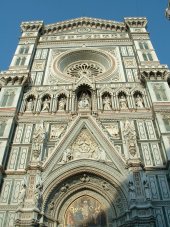 St. Maria del Fiore, Florence
Photo: BPG
International Piano Festival - Amalfi
July and August
The Chiostro del Paradiso is the setting for concerts by Italian and foreign pianists who alternate playing every Friday.
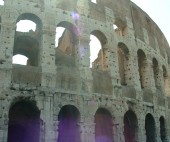 The Colosseum, Rome
Photo: BPG
MUSICAL WEEKS
Siena
August
Accademia Musicale Chigiana
Via di Città 89 - 53100 Siena
Tel. 39 0577 46152
Fax 39 0577 288124
Spoleto
June - July
Associazione Festival dei Due Mondi
Piazza Duomo 8 - 06049 Spoleto
Tel. 39 0743 220320 or 45028 or 40619
Fax 39 0743 220321
e-mail: spoletofestival@krenet.it
Torre del Lago Festival Pucciniano
August
Torre del Lago Puccini
Piazzale Belvedere 4 - 55048 Viareggio (Lucca)
Tel. 39 0584 350562
Fax 39 0584 350277 or 350562
Umbria Umbria Jazz
July
"Associazione Umbria Jazz"
P.O. Box 228 - 06100 Perugia
Tel. 39 075 62432
Fax 39 075 5730053
Viterbo Baroque Music Festival
August
Palazzo Santoro - Piazza Verdi 4/A 01100 Viterbo
Tel.39 0761 326666
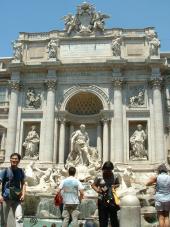 The Trevi Fountain, Rome
Photo: BPG
Ivrea Carnival
Early January
(lasts for 5 days)
In 2001 the carnival celebrated its 194th edition, but the area had started celebrating the events as early as the 1600s. The fight for liberty, when the men of Ivrea "expelled" the Marquis of Monferrato, is recreated with the Battles of the Oranges, which substitute stones. To make it fun there are several orange throwing "teams", all sporting colorful uniforms. The Carnival also has a lot of parties, food events and music.
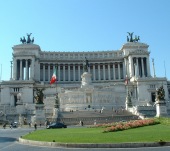 Vittorio Emanuele Monument, Rome
Photo: BPG
San Gennaro - Naples
September
San Gennaro, patron saint and protector of Napoli, stands for many as a symbol of the city itself, and his festival is one of the most passionately celebrated in all of Italy.
The festival ideally culminates in the miracle of the liquefaction of the blood of San Gennaro, which takes place every year more or less on the date of the festival. Many accept the divine nature of the event, and it is incontestable that the blood liquefies, but experts obviously differ on why or how this happens.
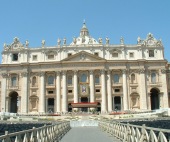 St. Peter's Basilica, Rome
Photo: BPG
Easter Sunday Florence
The annual 'holy fire' during Holy Week, is started with historical shards of the Holy Sepulchre, and is lit in the Church of SS Apostoli and transported to the Duomo, where the archbishop of the city lights the sacred 'Colombina' rocket with it during the Easter Mass. The rocket travels out of the Duomo along a wire, sets fire to the huge array of fireworks attached to the ICARRO and returns back into the church the way it came.
The celebration of the ceremony still bears a strong resemblance to the way in which it has been celebrated for centuries. On the morning of the day the Carro, pulled by two white oxen, leaves from Via del Prato for the Piazza del Duomo, accompanied by costumed revellers and various city officials and clerical representatives.
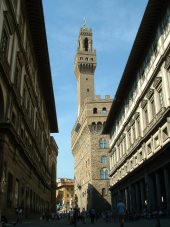 Palazzo Vecchio, Florence
Photo: BPG
The Palio delle Contrade,
Siena
July
A banner, decorated with an image of the Virgin Mary, is presented to the winner of a horse race around the Siena's Piazza del Campo. Competitors come from each one of the 17 districts of the city.
The race consists of bareback riders making three circuits of the main square and is over in 90 seconds. But it is preceded by 5 hours of flag throwing acrobatics around the main square.
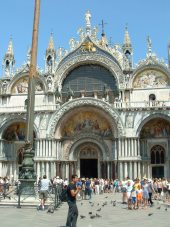 St. Marco Basilica, Venice
Photo: BPG
Viareggio
February - March
Every year The Viareggio Carnival is the most spectacular in Italy, and is known world-wide. The people of Viareggio begin preparing the huge papier-maché puppets in hangar-like buildings by the sea. The figures satirise public and political figures; making them and setting them atop the floats requires considerable technical skill as well as creativity and imagination.
The voluminous floats parade around Viareggio competing for the finest float award from 2.30pm until 9pm on the following dates: 11, 18, 25, 27 Feb and 4 March, each one carrying about 200 people in costume, as well as the huge moving, Trojan horse-like puppets, which hold people inside to manoeuvre the weights, counter-weights and levers that prevent them from toppling over.
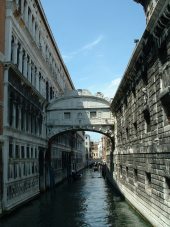 The Bridge of Sighs, Venice
Photo: BPG
|
|
|